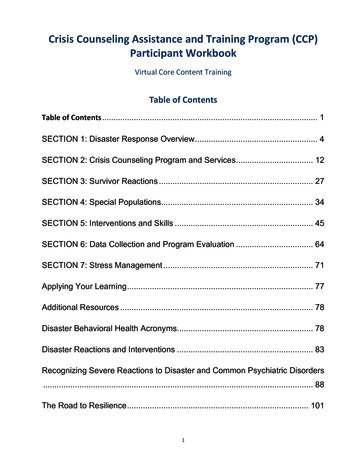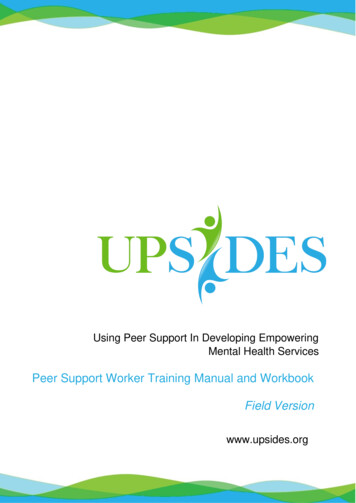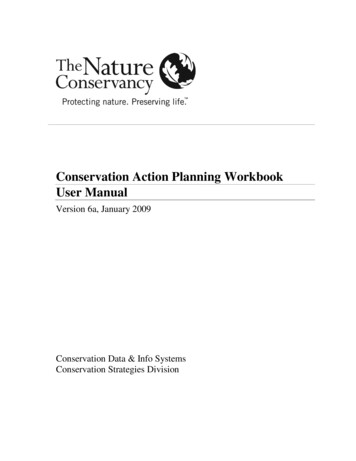
Transcription
Crisis Counseling Assistance and Training Program (CCP)Participant WorkbookVirtual Core Content TrainingTable of ContentsTable of Contents . 1SECTION 1: Disaster Response Overview . 4SECTION 2: Crisis Counseling Program and Services . 12SECTION 3: Survivor Reactions . 27SECTION 4: Special Populations. 34SECTION 5: Interventions and Skills . 45SECTION 6: Data Collection and Program Evaluation . 64SECTION 7: Stress Management . 71Applying Your Learning . 77Additional Resources . 78Disaster Behavioral Health Acronyms. 78Disaster Reactions and Interventions . 83Recognizing Severe Reactions to Disaster and Common Psychiatric Disorders. 88The Road to Resilience . 1011
CCP Participant Workbook: Virtual Core Content TrainingRecommended 8-Hour AgendaCore Content Training (Virtual Edition)A.M. (or Day 1) Schedule8:00 a.m. StartWelcome and IntroductionsDisaster Response OverviewCCP and Services9:45 a.m. Break10:00 a.m.CCP and Services (cont.)Survivor ReactionsP.M. (or Day 2) Schedule12:00 p.m. Lunch1:00 p.m.Special PopulationsInterventions and Skills2:00 p.m. Break2:15 p.m.Interventions and Skills (cont.)3:15 p.m. Break3:30 p.m.Data Collection and Program EvaluationStress ManagementQ&A, Applying Your Learning, Course Evaluation5:00 p.m. Adjourn2
CCP Participant Workbook: Virtual Core Content TrainingAfter training, participants will be able to do the following: Describe the range of crisis counseling services. Identify typical disaster reactions. Demonstrate basic crisis counseling skills. Explain the importance of data collection and how to use it. Apply techniques for managing stress.Guidelines for Working Together Keep time (start on time; return from breaks on time; end on time). Switch mobile phones off or to “vibrate.” Turn off computer notifications Mute yourself when you are not speaking so others can be heard clearly. Participate fully. Ask or submit questions freely. Balance talking and listening. Respect each other’s point of view.3
CCP Participant Workbook: Virtual Core Content TrainingSECTION 1: Disaster Response OverviewDefinitions of DisasterA disaster is a natural or human-caused occurrence (e.g., hurricane, tornado, flood,tsunami, earthquake, explosion, hazardous materials accident, mass criminalvictimization incident, war, transportation accident, fire, terrorist attack, famine,epidemic) that causes human suffering. A disaster creates a collective need thatoverwhelms local resources and requires additional assistance.Adapted from the Center for Mental Health Services (CMHS), 2000.A disaster is any natural catastrophe (e.g., tornado, hurricane, storm, high water, winddriven water, tidal wave, tsunami, earthquake, volcanic eruption, landslide, mudslide,snowstorm, drought) or, regardless of cause, any fire, flood, or explosion in any part ofthe United States that, in the determination of the President, causes sufficient severityand magnitude to warrant major disaster assistance under the Robert T. StaffordDisaster Relief and Emergency Assistance Act of 1974 (Stafford Act).Robert T. Stafford Disaster Relief and Emergency Assistance Act, 1974.Notes:4
CCP Participant Workbook: Virtual Core Content TrainingCharacteristics of This Disaster WorksheetCause:Size:Scope:Natural or Human-caused Disaster:Impact on survivors:5
CCP Participant Workbook: Virtual Core Content TrainingNatural v. Human-Caused DisastersNaturalHuman-CausedEarthquakes, fires, floods, tornadoesAirplane crashes, chemical leaks, massviolence, terrorismNo one to blamePeople, governments, or businesses toblameBeyond human controlSeen as preventable and a betrayal byfellow humansAdvance warning is possibleNo advance warningPost-disaster distress is high and feltmainly by survivorsPost-disaster distress is often moreintense than the distress experienced bypeople after natural disasters, and it is feltby more people not directly affected by thedisaster6
CCP Participant Workbook: Virtual Core Content TrainingFederal Emergency Management Agency (FEMA) Disaster AssistanceFEMA Disaster Operations StructureThis chart reflects a typical disaster response structure in the immediate aftermath oflarge, usually natural, disasters.In a typical disaster, it is the responsibility of the FEMA region where the disasteroccurred to carry out the initial response, do damage assessments, set up a joint fieldoffice, and deploy staff.Immediately after the declaration, FEMA disaster workers arrive and set up a centralfield office to coordinate the recovery effort. A toll-free telephone number is available foruse by affected residents and business owners in registering for assistance (1-800-621FEMA [3362] or TTY 1-800-462-7585 for people with speech or hearing needs).Disaster recovery centers are open for disaster survivors to meet with programrepresentatives and obtain information about available aid and the recovery process.7
CCP Participant Workbook: Virtual Core Content TrainingTypes of Assistance Available From FEMAThe Presidential disaster declaration will specify the types of assistance for which a stateis eligible.Hazard Mitigation—Disaster survivors and public entities are encouraged to avoidthe life and property risks of future disasters. Examples include the elevation orrelocation of chronically flood-damaged homes away from flood hazard areas,retrofitting buildings to make them resistant to earthquakes or strong winds, andadoption and enforcement of adequate codes and standards by local, state, andfederal governments.Public Assistance—Aid to state or local governments to pay part of the costs ofrebuilding a community's damaged infrastructure. Generally, public assistanceprograms pay for 75 percent of the approved project costs. Public assistance mayinclude debris removal, emergency protective measures and public services, repairof damaged public property, loans needed by communities for essential governmentfunctions, and grants for public schools.Individual Assistance—Includes FEMA CCPs and is covered in detail in thissection.Notes:8
CCP Participant Workbook: Virtual Core Content TrainingOverview of CCPEntities eligible to apply for and receive CCP funding: States U.S. territories Federally recognized tribes and tribal organizationsThe CCP consists of two grant types: Immediate Services Program (ISP): 60 days Regular Services Program (RSP): up to 9 monthsCCP Typical Timeline9
CCP Participant Workbook: Virtual Core Content TrainingISP Organizational Roles and ResponsibilitiesThe FEMA JFO Program Specialist Works with the SAMHSA Project Officer, the state, and the CCP to ensurethe quality, consistency, and fiscal management of the program. Provides information to the state about FEMA requirements and regulationsrelated to the CCP.The SAMHSA Project Officer Works with the state and the CCP staff to ensure that the program runsconsistently and efficiently. Provides ongoing technical assistance (TA) to the state and FEMA onprogrammatic, behavioral health, and budgetary issues. Works with the CCP leadership to ensure ongoing services are relevant andfiscally consistent.FEMA Headquarters Works with the SAMHSA Project Officer, the state, and the CCP to ensurethe quality, consistency, and fiscal management of the program. Confers with the FEMA JFO Program Specialist and the SAMHSA ProjectOfficer as needed.State Disaster Behavioral Health Coordinator Works with the SAMHSA Project Officer, FEMA, and the CCP to ensure thequality, consistency, and fiscal management of the program. Is responsible for CCP reporting. Manages the CCP including oversight in hiring and training of CCP staff.10
CCP Participant Workbook: Virtual Core Content TrainingThe Substance Abuse and Mental Health Services Administration (SAMHSA)Disaster Technical Assistance Center (DTAC) Provides TA to the SAMHSA Project Officer, FEMA, and the CCP. Is a resource for materials and trainings.Notes:11
CCP Participant Workbook: Virtual Core Content TrainingSECTION 2: Crisis Counseling Program and ServicesThe CCP model is . . .Strengths based—While CCP workers may assess significant adverse reactions andrefer people accordingly, program services assume natural resilience in individuals andcommunities.Anonymous—People should not be classified, labeled, or diagnosed. Each personshould be seen as unique in his or her needs and recovery. Therefore, there are nocase files, records, or diagnoses for users of CCP services.Outreach oriented—Crisis counselors take services into the community rather thanwaiting for survivors to seek services.Culturally aware—Throughout the project, staff should strive to understand and respectthe community and the cultures within the community.Conducted in nontraditional settings—Crisis counseling is community based andoccurs primarily in homes, community centers, disaster shelters, and settings other thantraditional mental health clinics or hospitals.Designed to strengthen existing community support systems—The CCP supportsbut does not supplant natural community support systems. Likewise, the crisiscounselor supports community recovery activities but does not organize or managethem.Based on an assumption of natural resilience and competence—Most people willrecover and move on with their lives after a disaster, even without assistance. Promoteindependence rather than dependence on the CCP, other people, or other organizationsand assume competence in recovery. A key step in recovery is regaining a sense ofmastery and control.12
CCP Participant Workbook: Virtual Core Content TrainingTraditional Treatment v. Crisis Counseling Traditional TreatmentIs office-basedMay involve diagnosis andtreatment of mental illness, as wellas identification of strengths andcoping skillsMay focus on longer-term issuesValidates experiences associatedwith distress that has brought theperson to treatmentKeeps records, charts, case files,etc. Crisis CounselingIs home- and community-basedInvolves identification of strengthsand coping skillsCounsels on disaster-relatedissuesValidates common disasterreactions and experiencesDoes not collect identifyinginformationNotes:13
CCP Participant Workbook: Virtual Core Content TrainingReach of Services14
CCP Participant Workbook: Virtual Core Content TrainingOverview of CCP ServicesIndividual crisis counseling—Assists disaster survivors in understanding their currentsituations and reactions, reviewing their options, and linking them with other individualsand agencies that may assist them. During individual services, crisis counseling staffare active listeners who provide emotional support. Individual crisis counseling alsoincludes working with the family as a unit. This service is more than 15 minutes induration.Brief educational or supportive contact—The number of brief contacts withindividuals, or groups of individuals, that did not result in indepth discussion orinteraction of an educational or crisis counseling nature. This service is 15 minutes orless in duration.Group crisis counseling—Involves providing and facilitating support or education to agroup to help members cope with their situations and reactions.Public education—Involves the distribution of educational information on CCP or crisiscounseling-related topics. Educational information may be provided via publicpresentations, brochures, flyers, mailings, and training to human services personnel.The media are often partners in providing information through public serviceannouncements, newspaper articles, and advertisements.Assessment, referral, and resource linkage—Assessment determines the need forreferral. Referrals can link survivors experiencing severe reactions with formal mentalhealth and substance abuse treatment. Referrals also can direct survivors to otherdisaster relief resources in their community to meet physical, structural, or economicneeds.Community support and networking—Supports every other service delivered by theCCP. CCP staff participate in, but do not initiate or lead, community support activities(e.g., being present at remembrance events). Crisis counselors can provide a“compassionate presence” and be available to provide crisis counseling services, shouldthe need arise.15
CCP Participant Workbook: Virtual Core Content TrainingNeeds Assessment WorksheetIdentify the geographic areas affected in the disaster.Who are the special population groups?What are the priority needs in the affected communities (e.g., rebuilding/repairinghomes, employment, treatment)?16
CCP Participant Workbook: Virtual Core Content TrainingResource Identification WorksheetFor several of the priority needs selected, identify the community resources that wouldbe needed to meet those needs (e.g., community organizations such as faith-basedorganizations, disaster assistance organizations, schools).17
CCP Participant Workbook: Virtual Core Content TrainingOutreach Strategy WorksheetWhat are the key actions this program should take to conduct successful outreach tosurvivors?What key actions can you take to conduct outreach to organizations that have resourcesavailable for survivors?18
CCP Participant Workbook: Virtual Core Content TrainingIndividual/ Family Crisis CounselingEncounter Characteristics This service consists of encounters or visits with adults and children. It can last 15 minutes or longer. It typically ranges from one to five visits. The number of visits provided should be determined through discussions withsupervisors and teams. Multiple visits may indicate a need for referral to longer-term services andshould be discussed with supervisors. Each visit should stand alone. Crisis counselors should reinforce priorsuccessful coping skills in addition to helping survivors develop new ones.Goals and Objectives Engage—Through outreach, make contact with affected individuals toprovide crisis counseling services. Identify immediate needs—Assist survivors in assessing their currentneeds. Gather information—Use reframing, reflecting, paraphrasing, and openingskills to gather information to assess the survivor’s needs. Prioritize needs—Disaster survivors often have safety and physical needsthat need to be met first. Provide practical assistance—Provide referrals and linkage to additionalservices including disaster assistance, clothing, food, and shelter. Provide education—Teach survivors about common reactions, stressmanagement techniques, and coping skills. Provide emotional support—Normalize the survivor’s reactions, andprovide reassurance. Determine next steps and follow up—Assist the survivor in developing aplan and creating action steps.Brief Educational or Supportive Contact This service is less than 15 minutes long. It provides reassurance, other support, and information. Activities, such as brief interactions, telephone calls, and handing outbrochures, are examples of brief educational or supportive contact.19
CCP Participant Workbook: Virtual Core Content TrainingGroup Crisis CounselingEncounter Characteristics Group crisis counseling refers to services that help group membersunderstand their current situations and reactions to the disaster, help themreview or discuss their options, provide emotional support or referral services,and provide skills to cope with their current situations and reactions. In groupcounseling, participants do most of the talking. Group counseling encounters last 15 minutes or longer. The CCP focuses on two types of groups: support and education groups, andself-help groups. Group counseling may vary from less structured, purely educational groups tomore structured support groups. All groups are likely to share someelements of support and education. Groups can be led by a licensed mental health professional, co-facilitatedwith a mental health professional and a paraprofessional, or led by survivorsthemselves. When members of social support networks are struggling with the disaster’saftermath, counseling groups may augment overloaded support systems. It is important to ensure that group members have had similar levels ofexposure to the disaster event. People with low exposure should not beexposed to the stories of those whose exposure was significantly higher.Support and Educational Groups Increase the social support network. Facilitate exchange of information on life situations. Help develop new ways of adapting and coping. Provide tools to obtain and process new information. Provide practical and concrete assistance. Use handouts and factual information relevant to the group’s discussion. Use speakers relevant to content area and group members’ needs.Tips for Starting and Facilitating Support and Educational Groups In a support group, it is acceptable to allow members to begin the dialogue.Keep track of time, and facilitate discussion. It may be helpful to have homogeneous membership (e.g., bereaved parents,neighbors, occupational groups, women, children). The format and content of the group and educational materials presentedshould be tailored to meet the developmental and cultural needs of groupmembers. Consider accessing written resources in various languages and20
CCP Participant Workbook: Virtual Core Content Trainingmaterials geared toward people with disabilities and targeted towardchildren’s developmental stages. Speakers may include mental health and substance abuse professionals,public health workers, faith-based leaders, community leaders, and disastersurvivors. People need to be emotionally ready to participate in group crisis counseling.Bringing people together too early can be detrimental. Use caution indeciding when to begin group crisis counseling.Self-Help Groups Are initially facilitated by a crisis counselor. Can be co-facilitated by a group member to encourage transition to amember-facilitated process. Are no longer a CCP service once the group has transitioned to a memberfacilitated process.Practical Concerns in Group Crisis Counseling Counselors should assess their own skills and knowledge about the group’scontent to set clear boundaries on how to approach the group process.Group members may inquire about symptoms on which counselors are notauthorized to give advice. Counselors can, however, provide concreteinformation and make appropriate referrals to mental health professionals. Be aware of personal biases related to religion, spirituality, culture, ethnicity,and gender. It is common and healthy to recognize these qualities forpersonal reflection, but it is detrimental if these qualities disrupt the groupprocess. Respect and maintain confidentiality. A group should be in a safe place inwhich people, families, and communities can freely share their feelingswithout worrying about other people knowing their personal business. Facilitate the group by making sure that each member has a chance to talkand that no one person is dominating the conversation. Ask a member whohas not spoken if he or she would like to talk; however, respect his or herright to just sit back and listen. Ask for feedback. Some groups may warrant more structure than others will;however, it can be empowering for group members to become activelyengaged in the process of deciding what they would like to achieve in groupsessions.Public Education Includes distribution of information and educational materials Is likely to increase during the course of the CCP Is designed to do the following:21
CCP Participant Workbook: Virtual Core Content Training–Build resilience–Promote constructive coping skills–Educate about disaster reactions–Help people access support and services–Leave a legacy of knowledge, skills, and community resourcesDistribution of educational materials: This includes flyers, brochures, tip sheets, guidance, and website content. It covers the following topics:–Basic disaster information–Key concepts of disaster behavioral health–Disaster reactions–Coping skills–Individual and community resilience Contact SAMHSA DTAC for help in accessing educational materials. Culturally appropriate materials address special populations, are available inmultiple languages, and consider varying educational levels of survivors. Distribution of educational materials is captured on the Weekly Tally Sheet.22
CCP Participant Workbook: Virtual Core Content TrainingAssessment and Referral Assessment is the process of reviewing, identifying, and evaluating survivors’needs. The CCP screens for the following:––Practical or tangible needs of survivorsSubstance abuse and mental health needs Crisis counselors also identify resources in the community that match theneeds of survivors. The CCP Adult Assessment and Referral Tool may be used to assist crisiscounselors in making decisions regarding the need for referral. Crisis counselors provide information on available resources to meet tangibleneeds.–––––Crisis counselors help survivors meet unmet needs through resourcelinkage.Services are provided regardless of level of functioning.Resource linkage empowers survivors to advocate for themselves.Crisis counselors assist survivors in prioritizing and accessing services.Relationships with survivors are short term.Assessment and Referral Considerations Amount of time since the event—Some reactions are very common in thefirst few weeks and, by themselves, do not necessitate referral. Poorfunctioning, avoidance of situations, and sleeping problems are common atfirst. Degree to which the symptoms are interfering with daily lifefunctioning—This includes how well the individual is managing his or hersymptoms, and how strong his or her support systems are.Emergency Treatment Referral Alert the team leader if you notice any of the following:––––– There is intent or means to harm self or others.A person exhibits severe paranoia, delusions, or hallucinations.Functioning is so poor that a person’s (or dependent’s) safety is indanger.Excessive substance use is placing a person or others at risk.A child’s safety or health is at risk.When in doubt, call 911, or refer for immediate psychiatric or medicalintervention.23
CCP Participant Workbook: Virtual Core Content TrainingNonemergency Treatment Referral Reduce perceived stigma:–Demystify mental health or substance abuse treatment by letting peopleknow that counseling and treatment are methods of support,information, education, problem solving, and coping.–Explore referral options, and give choices.Increase compliance:–Explore obstacles to accepting services.–Encourage the person to call for the appointment while the counselor isthere.–Accompany the person to the first appointment, if necessary andappropriate.Sometimes it is acceptable to guide survivors through the referral process.Some strategies include the following:–Provide referral options.–Assist them in making appointments.–Remind them to attend appointments.–Follow up to see if they attended.Facilitating the survivor’s connection with the external provider can increasefuture follow-through with treatment.24
CCP Participant Workbook: Virtual Core Content TrainingCommunity Support and NetworkingThrough community support and networking, the CCP engages in the following activities: Partners with community support systems Participates in community gatherings and rituals Reaches out to community groups and leaders Maintains a compassionate presence Bolsters, but does not replace, systems in placeThe CCP has the following goals for its community support and networking work: Foster community resilience through improved connectivity. Promote familiarity with disaster relief resources. Create a seamless system for referral. Create opportunities for shared resources and training. Make referrals to organizations and agencies, and do not limit referrals tothose for mental health and substance abuse treatment. Referrals can bemade for other disaster relief services as well. Share training resources, as appropriate, with other disaster relieforganizations. Use networking to help identify needs, referral sources, and sources of inkind donations.Community support and networking activities are captured on the Weekly Tally Sheet.25
CCP Participant Workbook: Virtual Core Content TrainingTypical Community PartnersOther potential partners: Emergency management Law enforcement Substance abuse prevention community Office for Victims of Crime Community-based cultural organizations American Indian and Alaska Native tribal community leaders Refugee organizations Suicide prevention organizations Mental health and substance abuse consumer groups26
CCP Participant Workbook: Virtual Core Content TrainingMedia Messaging and Risk Communication Media messaging and risk communication are important parts of acomprehensive disaster behavioral health plan and any CCP. An effectiveplan for engaging the media will get the word out about CCP resources andthe message of resilience. The CCP reaches large numbers of disaster survivors through mediacampaigns. Media messaging accomplishes the following:– Increases education and awareness for survivors– Promotes a shared understanding of the CCP message– Delivers a clear message regarding the CCP– Promotes the services of the CCP, such as the helpline, ongoing crisiscounseling, and referral– Shares information on common reactions and important talking points The SAMHSA publication Communicating in a Crisis: Risk CommunicationGuidelines for Public Officials is a good resource for planning communicationand dealing with the media. It is available online s/pep19-01-01-005.Developing a CCP media plan helps to do the following things: Identify spokespeople with expertise in the field of disaster behavioral healthand experience in dealing with the media. Develop simple talking points that reflect the goals and services of the CCP. Develop a press kit with information on the CCP and its services.There are several important points to consider when developing talking points: The CCP emphasizes resilience and hope. Help is available through a variety of services provided by the CCP. The CCP provides education on common reactions and teaches effectivecoping skills. Cultural diversity is respected in providing assistance. People often find stories of people like them interesting and compelling. Ifappropriate, and while maintaining confidentiality, highlight stories of peoplewho have been helped by the CCP.SECTION 3: Survivor ReactionsKey Concepts Everyone who experiences a disaster is affected by it in some way.27
CCP Participant Workbook: Virtual Core Content Training People pull together during and after a disaster. Stress and grief are common reactions to uncommon situations. People’s natural resilience will support individual and collective recovery.Vulnerability Factors Poverty Race Age Ethnicity Unemployment GenderRisk Factors ModelThe risk factors model helps identify potential populations who are most at risk foradverse reactions and potentially in need of crisis counseling services.A. Injured survivors, bereaved family membersHighest RiskB. Survivors with high exposure to disaster trauma, orevacuated from disaster zonesC. Bereaved extended family and friends, first respondersLower RiskD. People who lost homes, jobs, and possessions; people withpreexisting trauma and dysfunction; special groups; otherdisaster respondersE. Affected people from the larger community28
CCP Participant Workbook: Virtual Core Content TrainingSurvivor Reactions WorksheetFor the type of reaction assigned to your group, discuss the following:What specific reactions have you seen in this category—either in response to thisdisaster, or in previous experiences?What differences in reactions have you seen—or could you imagine—across agegroups?29
CCP Participant Workbook: Virtual Core Content TrainingSummary of Survivor ReactionsPhysical ReactionsCognitive Reactions Gastrointestinal problems Disorientation and confusion Headaches, aches, andpains Poor concentration Weight change Difficulty setting priorities ormaking decisions Sweating or chills Loss of objectivity Tremors or muscle twitching Clumsiness, increasedaccidentsRecurring dreams,nightmares, or flashbacks Preoccupation with disaster Increased reactivity tostimuli such as sound andlight (being easily startled) Chronic fatigue or sleepdisturbances Immune system disorders Sexual dysfunctionPositive responses can includealertness.Emotional Reactions Feelings of heroism,euphoria, or invulnerability Denial Anxiety or fear Depression Guilt Apathy GriefPositive responses can includefeeling challenged, involved, andpressured to act.Positive responses can includegroup identification and sharpenedperception.Behavioral Reactions Change in activity level Alcohol and drug use orabuse Increased use of over-thecounter medications Difficulty communicating orlistening Irritability, anger, or frequentarguments Declining job performance Frequent crying Difficulty sleeping Avoidance of triggeringplaces or activitiesPositive responses can includeunselfish a
CCP Participant Workbook: Virtual Core Content Training . 2 . Recommended 8-Hour Agenda Core Content Training (Virtual Edition) A.M. (or Day 1) Schedule 8:00 a.m. Start Welcome and Introductions . Disaster Response Overview . CCP and Services . 9:45 a.m. Break 10:00 a.m. CCP and Services (cont.) Survivor Reactions . P.M. (or Day 2) Schedule










